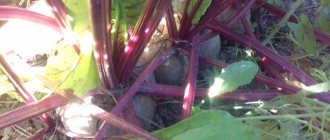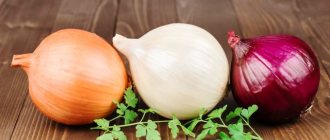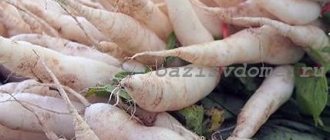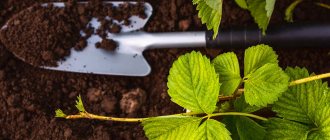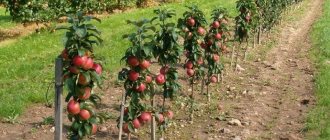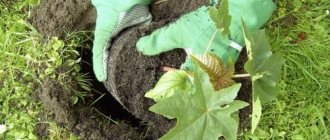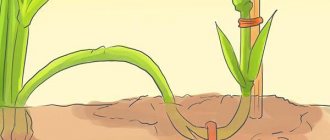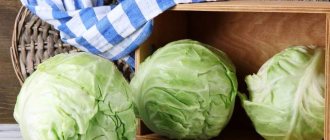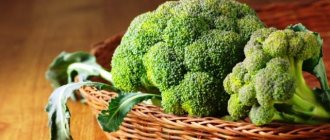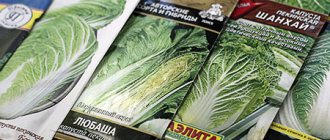The quality of onions directly depends on compliance with harvesting rules and determining the timing of this procedure
The exact dates have been determined when it is best to harvest onions in 2021 according to the lunar calendar. Advice and recommendations from experienced farmers will help you calculate the most successful days for harvesting a ripe crop. They will help you figure out how to properly harvest and store the crop so that all the beneficial properties of the spicy vegetable are preserved.
How to determine the ripeness of onions?
The quality of onions directly depends on compliance with harvesting rules and determining the timing of this procedure. The ripeness of the bulbs can be recognized by the external signs of the above-ground and underground parts of the plant, and can also be calculated mathematically.
The timing of harvest depends on many conditions. The most important criterion that determines the timing of ripening is the selected variety. Onions with early, middle and late ripening limits can be planted. Weather conditions play a significant role. In cold, rainy summers, ripening dates shift by several days or even weeks.
When to harvest onions: reviews
It is very difficult to guess the weather and accurately determine the ripeness of onions. Poor keeping quality is not always associated with incorrect harvest dates.
When to harvest onions, reviews:
Victoria . I don’t have a garden, but I have a small plot near a private house. I grow parsley and onions on it. This year I decided to plant regular onions. Focused on the state of the green part. When the leaves began to wither, dry out and turn yellow, they dug up the onions. The heads are quite decent in size, with a dense husk. I did not intend to store it for a long time, since there was little planting material. We ate it in just a couple of months.
Miroslava . I have a large dacha where I grow almost all vegetable crops, including onions and garlic. Onions turned out to be one of the difficult crops for me, since I couldn’t guess the harvest time. The year before last I was guided by the lunar calendar, as a result it did not last long. I think I left it too long in the ground; it needs to be dug up much earlier. Last year, the onions were stored longer, as a dense film and several layers of dry husks formed. But the heads turned out to be small. I think it's a matter of lack of feeding. In general, I am satisfied with the quality of the onion; it was well stored in a net on the balcony.
Olga. I have a large family, so I use a lot of onions over the winter. I start planting onion sets in early spring. I harvest in early September, since I live in Siberia. Due to the rainy, cold summer, it does not always have time to fully ripen. This is why I often speed up the ripening process. I dig it out 1/3 with a pitchfork, leave it to dry under a canopy, without tearing off the tops. Only after the onion is ripe do I cut off the tops and carry out final processing and preparation for storage. Usually there are no problems. I rely on planting dates and weather conditions. After all, Siberia has changeable weather, often cold summers, and several days of heat.
Onions
Interesting articles about growing and using onions can be found on our website:
- Onion masks for hair loss: 3 best recipes, tips
- Folk recipes with onions for cleaning blood vessels, for kidney stones, for headaches and hypertension, for vision and good sleep
- Traditional recipes with onions for colds, flu, bronchitis
- Onions for intestinal diseases, diabetes - use: folk recipes
- Growing greenery on a windowsill in an apartment all year round: instructions
Gardeners claim that crops collected on a rainy day are stored much worse. It is necessary to allocate another 7-10 days for complete drying under a canopy. This worsens the taste of onions and also shortens the shelf life. That is why gardeners tend to dig the crop out of dry soil on a sunny day.
External signs of maturity
External signs that can serve as a guide to starting to dig up ripe onions include:
- stems that were previously straight and green begin to dry, turn yellow and wither;
- the neck of the bulb becomes thinner, turns yellow and fades;
- feathers begin to spread along the ground (if the summer is cool, then this symptom may appear before the heads ripen);
- The scales of a ripe bulb are dry, golden in color and peel off easily.
Important nuances of drying and storing bulbs
The bulbs are considered dried when the moisture content of the scaly coating is 14–15%. The main thing is that when drying, the onion scales do not crack, otherwise the vegetable becomes vulnerable to bacteria.
Containers for storing onions are filled with ash, sawdust or salt. An old tradition is that the bulbs are hung from the ceiling in worn stockings or net bags. Aesthetes prefer to weave beautiful “braids” from dry stems to secure onion bunches. Onion compositions decorate the interior in country style.
IN THE PHOTO: Bow braids - beauty and convenience “in one bottle.”
Storing onions and garlic is easier than it seems, if you remember the basic rules. Learn all about storing onions and storing leeks from separate articles, and may your crop survive the winter successfully!
Mathematical method
You can calculate when to remove onions from the garden for storage using a simple mathematical method.
In order to calculate what date is best to dig up bulbs, you need to solve a simple example. 70–90 days are added to the date when the onion was planted. The amount received will serve as the starting point for harvesting. The number of added days depends on the selected variety.
When calculating the ripening time, you need to take into account weather conditions. If the weather is hot and dry, then you can harvest the onions earlier than the calculated date. In case of cold weather and rain, you need to add a few more days to the resulting number.
Storing onions at home
Onions are a necessary vegetable and, of course, every family has one. Many people stock up on vegetables for the winter, but do not know how to preserve them until the fresh harvest so that they do not dry out during storage. There are several storage methods, which depend on the variety - onions, leeks, sets or green onions. When storing at home, you should know and follow some conditions:
- Choose healthy and well-dried bulbs for storage;
- It is necessary to trim the roots and feathers correctly;
- Remove dry bulb scales;
- They are dried again and sorted again, leaving the best specimens for winter storage.
How to store the crop is also an important point. The main condition when storing onions is access to air, that is, the container must have holes for air circulation. This way you will prevent rotting. In an apartment, onions should be placed in ventilated places, for example, a pantry, closet, or simply hanging on the wall are perfect.
Often when storing at home, a problem arises when onions begin to sprout. The reason is high humidity in the room where the onions are stored. In such cases, the root bundle is treated with lime paste. To prevent germination, the roots are often burned, but this method is not suitable for sowing, since it is planting material and the roots should not be damaged.
Sweet varieties of onions need to be stored at a temperature ranging from 15 to 18 degrees, spicy varieties require low temperatures (-4 degrees).
Moon calendar
In places with moderate climatic conditions, according to the lunar calendar 2021, it is recommended to start collecting ripe heads in early August (starting on the 7th). At this time, the Moon will be in its waning phase. This will have a beneficial effect on the further process of drying and storing the crop. In areas where heavy rainfall occurs frequently, it is recommended that you begin digging before the rainfall period begins.
If you are wondering whether it is possible to remove onions during a new moon (crescent moon, waxing), the answer is yes. The new moon period is characterized by a slowdown of all biological processes in the above-ground parts of plants. At this time, weeding, weed control and pest control should not be carried out. But you can collect ripened root crops. All the power of plants goes into the underground part. Therefore, the harvest harvested during the new moon is juicy and fortified.
Good days according to the lunar calendar when bulbs can be collected will be August 2, 8, 13, 14 and 20. The unfavorable period is from August 4 to August 7. At this time, it is better to loosen the soil.
Country life hack
The phases of the moon, which the lunar calendar takes into account, have no less influence on the quality and quantity of the harvest than other factors. It has long been noted that plants grow and develop differently in different phases of the moon.
During the waxing moon, all juices flow from the roots to the above-ground parts of the plants. At this time, crop growth is activated. It is not recommended to harvest root crops during this period.
The waning moon is characterized by plants going to rest. All strength and juices rush to the roots. It is during the waning moon that it is better to remove onions. The nutritional value of the bulbs will be at the highest level. The full moon is also considered a favorable period for harvesting onions.
How to properly dig onions from the beds?
Having determined the best time for harvesting onions in 2021, you need to begin preparatory work:
- Two weeks before the expected date of digging the bulbs, stop watering the beds. If it rains, it is better to cover them with film. This will allow the heads to dry, which will have a beneficial effect on the storage of the harvested crop.
- It is best to start work early in the morning to have more time to dry under the sun.
- It is not recommended to pull out the bulbs by hand. The root crop can sit firmly in the ground and only damage the tops. It is better to use a shovel or pitchfork. After carefully digging into the ground, they pull out the vegetable.
- The dug up crop is laid out in one or two layers on previously prepared material, carefully shaking off the adhering soil. Periodically you need to stir the onion so that different sides are exposed to the sun's rays.
- After digging, do not immediately cut off the tops. It is left until the bulbs are completely dry (the drying process takes about two weeks). The tops contain many nutritional components that will continue to reach the onion heads for a long time.
If you miss the harvest time (harvest earlier or later than the recommended date), the risk of early rotting increases. Such vegetables are poorly stored and do not have high taste.
Preparing root vegetables for storage
It is necessary to properly prepare onions so that they can be stored longer. The preparation procedure boils down to drying, trimming leaves and sorting the vegetable.
Feather Trimming
Whether or not to trim the feathers depends on how you plan to store the onions. If you store it the old fashioned way, by braiding the heads, the feather should be left untouched. If the vegetable will be stored in boxes or other containers, the above-ground part is cut off, leaving a stump 5 cm long.
Pruning is done after the onions have dried before storing them. At the same time, the roots are cut off. Some of the heads that are planned to be used for planting do not have their roots trimmed.
On a note! Feathers cannot be trimmed close to the onion, because in this case it will be easier for pathogenic microflora to get to the inside of the vegetable and spoil it.
Drying
They dry the onions directly in the garden bed, using boards as a base, but only if the weather is good.
If the forecast is for rain, the heads are placed in a saran or under a canopy, spread out in one row for 1-2 days.
Further drying continues in a dry, warm room with good ventilation. This could be a closed veranda, the attic of a house, or a warm barn.
Onions can be braided and hung, or laid out on material, in nets, lattice boxes raised above the floor. The heads are turned over daily to ensure even drying. After 1-2 weeks, the harvest can be harvested for long-term storage. The sign that the onion is dry will be its appearance.
A properly dried vegetable should have a thin, dry neck, dried roots and a rustling husk.
Onions that were picked from wet soil require special drying conditions. The harvest is kept for 8 hours at a temperature of 40° C. Additionally, you can sprinkle the heads with crushed chalk, this will guarantee the preservation of the onions for several months.
Bulb sorting
Before the onions are transferred to storage, they are sorted. Not all crops will be stored equally long. Heads with signs of damage, rot, without top scales, or with a thick neck should be separated and used primarily for cooking. Only strong, even onions with dense covering scales and no signs of disease are stored well.
Leek
The timing of digging up leeks is affected by weather, variety, and climatic conditions. If the onions are not supposed to be stored in winter, you can harvest them as early as August. When a vegetable needs to be prepared for storage, harvesting begins only in early October.
Leek leaves should not turn completely yellow, much less wither and dry out. If warm, sunny weather with periodic rains prevailed in the summer, then you can harvest the crop 8–10 days earlier. In rainy summer conditions, onion harvesting should also begin earlier. This will avoid rotting and it will be possible to dry the crop fairly well.
What is the danger of untimely harvesting of onions?
Harvesting onions too early or too late can lead to problems with further storage.
If you dig up onions too early , you can get:
- unformed covering scales;
- excessively thick neck;
- penetration of harmful microorganisms into the bulb;
- rapid deterioration during storage.
Late harvesting of onions upsets the owner:
- cracking and falling of the dried scaly layer;
- re-sprouting of roots;
- low resistance against diseases;
- loss of most of the harvest.
IN THE PHOTO: An extra few days in the garden in damp, cool weather will lead to bulb rot later on. The photo shows a full picture of the rotting of the bulb, but it usually begins from the neck - the most vulnerable place of the bulb.
Sevok
Onion sets act as planting material, and the harvest of next years will depend on its quality. You can grow sets yourself from nigella seeds, or you can buy ready-made sets in the store.
Onion sets begin to ripen 90 days after planting. The most successful period for removing seedlings from the beds is considered to be from the beginning of August to the middle of the month. By this time, the tops dry out, turn yellow and fall to the ground.
You need to dig up onions from the ground earlier if the weather is rainy. In this case, the seedlings will take new roots, and the harvested crop will not be stored for long. After planting in the spring, active flowering will begin and the yield will decrease.
Why does the housewife need a lot of onions?
Onions are a favorite vegetable of many housewives, gardeners, and cooks. Without onions it is difficult to prepare delicious borscht, salads, vegetable stews, meat and fish dishes. This vegetable can cure colds. You cannot do without it during the rampant flu, ARVI, for the treatment of many skin diseases.
Each gardener plants enough onions to last throughout the winter fresh and for preparing vegetable preparations, sauces, and marinades.
No one needs to be reminded that onions contain many useful vitamins and microelements. This is a real repository of everything useful for the body. Therefore, every gardener rejoices when he sees a rich harvest of this treasure.
In order for the vegetable to last until the new harvest, we collect it for storage on time: not too early and not too late.
If you violate the deadlines, for example, collect early, then the scales will not cover the head well. And an unprotected turnip will become a haven for harmful bacteria, which means it will begin to rot faster. This onion is suitable for harvesting, but it is not suitable for storage. But most importantly, there will be a decrease in taste and usefulness.
When sitting in the ground, onions may begin to sprout, and in rainy weather they may simply rot.
shallot
The difference between shallots is the presence of not one, whole head, but several cloves. Externally, in color and shape, it is similar to garlic. Shallots are distinguished by earlier ripening, a long shelf life and the content of a large number of nutritional components.
They begin to harvest shallots from the beds when the feathers turn yellow, dry, and sink closer to the ground. Similar signs appear around mid-July. You must not miss the harvesting time, otherwise new roots will appear and the shelf life will be significantly reduced. Each bulb is dug up with a pitchfork and dried for about 10 days. Then the tops are cut, leaving a stump of 4 cm.
Many people harvest shallots according to the dates indicated in the lunar calendar. The most successful collection period is during the full moon. At this time, the harvest is the most juicy and ripe.
How to speed up the ripening process?
If it's time to harvest or heavy rains are forecast and the tops are still green and straight, there are a few clever tricks you can use to help your crop ripen faster. All work on the garden bed: watering, fertilizing must be completed two weeks before the expected harvest date. Besides this, there are other tricks.
Stop watering
Harvesting is carried out before the period of prolonged rains. At the same time, stop watering the plants. Moisture promotes the growth of feathers and the appearance of new roots, which prevent the bulbs from ripening.
Undermining the roots
If the soil is loose, you can manually pull the bulbs a little to tear the roots. You can dig up the heads with a shovel, but do not remove them from the garden bed, but leave them in that position. It will be possible to harvest crops with damaged roots earlier.
Exposure of bulbs
If the onion heads are planted deep, a method of pushing the soil away from each head will help. Being exposed, it receives more light, air and ripens faster.
Sometimes the roots of the bulb are cut off by about 5 cm. It is not recommended to mow the above-ground part of the plant. This can lead to complete loss of the crop. Onions dug up ahead of schedule can ripen precisely thanks to the tops, which contain many nutritional components.
How to trim and dry
Having dug up a garden crop, it must be dried well for 15-20 days. For high-quality drying, favorable conditions are necessary: warmth and fresh air.
Drying methods
The most effective method of drying onions is in an open-air area in sunny weather. The bulbs are laid out in a row, and the feathers are directed in one direction. In this position it will be easier to turn them. At night, the crop can be covered with film, or better hidden under a canopy.
If the weather is cloudy and it is drizzling, the dug vegetables are taken to a dry room. It is good if it has a ventilation system. In any case, the room should be well ventilated. It is even recommended to open the windows for a draft. It is important to turn the bulbs more often.
As a last resort, dry in the oven at a temperature of +44°C. This procedure should be done no longer than 8 hours. This method is not ideal, but it can save turnips collected in rainy weather from rotting. You can set the temperature to +33°C, then the drying time is extended to 5 days.
Onion seeds are cut off and placed in one layer in a dry place. There, they will ripen for 20 days; they are constantly stirred so that they do not begin to germinate. In addition, stale feathers can become moldy.
Pruning rules
After the onion has dried a little, its roots and feathers are trimmed. If this operation is not performed in a timely manner, the bulbs will not be able to dry properly.
When trimming leaves, do not cut off the neck. If you cut it down to the vegetable itself, it will begin to rot during storage. If onions are to be stored in wreaths, then the leaves are cut off, leaving 4-5 cm for possible weaving. The roots are not cut off completely: there should be 0.5–1 cm left to the bulb. Before storing the leek, wash it well.
How to tell if an onion is dry
Experienced gardeners store onions, focusing not only on the timing of drying the crop. There are some signs that indicate that the bulbs are dry and can be sent for storage.
- When the heads are stirred, they rustle.
- The top layer of husk falls off.
- The husk takes on a golden color.
- The neck is significantly reduced in size.
- The hand easily fits under the onion layer.
Important! The bulbs should not be overdried, as the protective scales may crack. As a result, the lower layers of the scales will be exposed, and the onion crop will not be able to survive until the required time.
